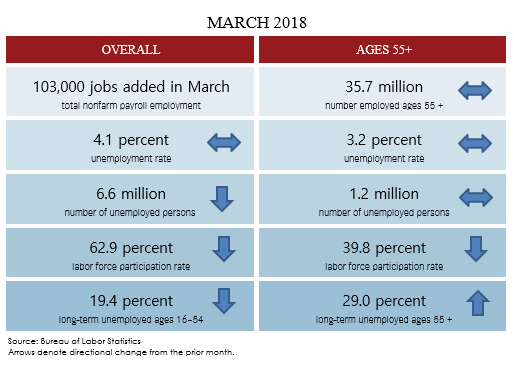AARP Hearing Center
Job Growth Slows in March but Employment Indicators for the 55+ Hold Steady
By Jennifer Schramm, April 6, 2018 05:19 PM

Employment Overview
The Bureau of Labor Statistics (BLS) March Employment Situation Summary showed that after a strong February with the strongest jobs growth since July 2016, hiring slowed down in March. The economy added 103,000 jobs and the labor force participation rate was down slightly at 62.9 percent. For the sixth consecutive month, the overall unemployment rate was 4.1 percent.
Meanwhile, many employment indicators for those ages 55 and older remained unchanged from February. The unemployment rate for people ages 55 and older held steady at 3.2 percent, as did the number of persons ages 55+ who were employed (35.7 million) and unemployed (1.2 million). The labor force participation rate for those ages 55+ decreased slightly from 39.9 percent to 39.8 percent, but the percentage of 55+ jobseekers considered long-term unemployed (those job searching for 27 weeks or more) increased from 27.2 percent in February to 29 percent in March.
Spotlight on Unemployment Among Veterans
About 8 percent (20.4 million) of the civilian population ages 18 and older were veterans in 2017. In March 2018, the BLS released data on veterans’ employment status from the Current Population Survey (CPS), a monthly survey of about 60,000 households in the U.S. The unemployment rate for all veterans declined from 4.3 percent to 3.7 percent in 2017.
Veterans are current civilians who have served on active duty in U.S. Armed Forces. While men are more likely to be veterans, about 10 percent of veterans are women. Veterans also tend to be older than the overall civilian population. Veterans who served during World War II, the Korean War, and the Vietnam War are now all over 60 years-old and accounted for 39 percent (8.1 million) of the total veteran population in 2017. Thirty-six percent of veterans (7.4 million) served during Gulf War era I (1990—2001) or Gulf War era II (from September 2001 onward) and about a quarter served outside the designated wartime periods.
The unemployment rate for male veterans (3.6 percent) declined over the year while the rate for female veterans (4.1 percent) changed little during the year. Unemployment rates for veterans vary by age. Four percent of the 370,000 unemployed veterans were ages 18 to 24, 59 percent were ages 25 to 54, and 37 percent were ages 55 and older.
Disability is often associated with higher rates of unemployment. However, in 2017 there was little difference in unemployment rates between veterans with a service-connected disability (4.3 percent) and those without one (4.5 percent).
Find more details on the latest employment data in the March Employment Data Digest, PPI’s monthly review of job trends for those ages 55 and over.
































































